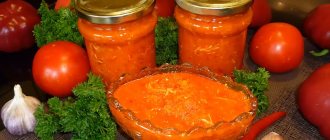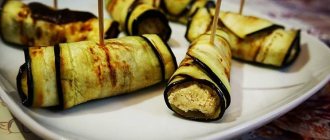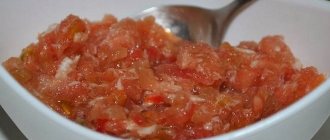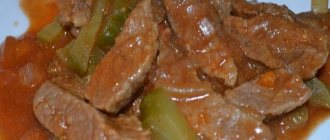The calling card and pride of Caucasian cuisine, Abkhaz adjika has a recognizable spicy taste and does not contain any chemical additives or preservatives. It contains only natural ingredients: hot pepper, salt, spices. Adjika is used in the preparation of many dishes as an aromatic and spicy additive. It goes great with fish, meat, and baked goods. It is added to sauces, soups, ketchups and mayonnaise.
It is best to buy this seasoning in the Caucasus, where it is made according to ancient family recipes. However, not everyone has this opportunity, and good adjika is eaten very quickly. In Russian stores you can see jars with the inscription: “Abkhazian adjika Amtsa.” But under what conditions and according to what recipe this product was made is difficult to say. To avoid getting into trouble, it’s easier to learn how to do the correct adjika once and no longer depend on circumstances.
Story
According to a beautiful legend, the recipe for Abkhaz adjika appeared thanks to the ingenuity of shepherds. When they took their flocks to mountain pastures, they were given salt, which had to be fed to the sheep so that the animals would eat, drink more and gain weight. Salt was a very valuable product, and to prevent theft, hot pepper was added to it.
But the effect was the opposite. The shepherds mixed hot salt with fragrant spices, and then ground the mixture between two flat stones. The resulting seasoning began to be added to food and was called adzhikttsatsa, which translated from Abkhaz means “salt ground with something.”
The most real adjika
The new seasoning turned out to be so tasty and versatile in use that it became firmly established in Caucasian cuisine. The flat stones that the shepherds used were replaced by special stones: a massive rectangular one with a recess where the adjika components were placed, and a small oblong stone used to grind the ingredients.
Generations followed each other in a row, and the seasoning recipe remained virtually unchanged. The ratios of products could vary in different families, but the composition of Abkhazian adjika remained the same: hot pepper, garlic, coarse salt, blue fenugreek and coriander seeds. All! No tomatoes, eggplants, zucchini or bell peppers. The additional spices added were the personal initiative of each individual housewife and an actual deviation from the standard recipe.
Until now, despite the advent of kitchen appliances, in Caucasian villages women prepare classic Abkhaz adjika using traditional stones. They believe that measured rubbing between stones is most effective in releasing and mixing the essential oils that the ingredients are rich in. The ground seasoning is not chopped, but similar to butter, delicate in consistency, incredibly aromatic, and most importantly - tasty and healthy. It’s not for nothing that Caucasians call adjika a cure for a thousand diseases.
Real Abkhaz adjika and principles of its preparation
This snack recipe is unique in that it is prepared quite simply, without the need for sterilization. In addition, the delicacy, well compacted in jars, will last in a cool place for more than one year.
List of ingredients in purified form:
- 0.5 kg of hot pepper pods;
- 200 gr. garlic cloves;
- in full 100 gr. a glass of utskho-suneli, coriander, saffron;
- 1 tsp. kondari;
- up to 125 gr. coarse rock salt, but not less than 1 tbsp. l. (taste).
1. Clean, dried pods must be removed from the stalk, cut lengthwise and the seeds removed. Next, grind the prepared pepper and peeled garlic through a meat grinder.
2. Dry ingredients are added to the spicy mixture.
3. Then the mass is kneaded until smooth. Since the mixture turns out to be very thick, it is extremely inconvenient to work with a spoon, so it is better to stir the snack by hand.
4. The resulting mixture is scrolled through the meat grinder again and placed in clean, dry jars under the lid, trying to compact the mass as much as possible. After which the filled glass container is tightly screwed and stored in a cellar or refrigerator.
Real adjika in Abkhazian style can be prepared in the following ways: use only dried ingredients, with the exception of garlic and grape vinegar, which gives the adjika the appearance of a paste (the so-called dry adjika) and cook mainly from fresh vegetables, which have a more pronounced aroma and vitamins (raw adjika).
But since the seasoning hop-suneli, which is part of adjika, contains the following components: parsley, celery, marjoram, basil, Imeretian saffron, fenugreek, etc., and it is almost impossible to collect them at the same time, this seasoning is added in dry form Therefore, this method of preparing adjika is called “half-raw”.
There are a lot of recipes for making adjika, but there is a set of basic ingredients:
- Herbs. It is thanks to coriander, dill seeds, hops-suneli, and utskho-suneli that adjika will have a pleasant aroma. If you add fresh herbs, the aroma of the seasoning will be more pronounced, but during the cooking process they will give the adjika a brownish tint.
- Pepper. It is necessary to choose juicy and meaty - the thickness of the seasoning depends on this. Hot chili pepper is added to adjika, as the hottest one, or as a “light” - softer.
- Garlic. The sharpness of the paste depends on its quantity. If the recipe calls for a large amount of hot pepper, then the amount of garlic can be reduced to 4-5 cloves.
- Salt. Real Abkhaz adjika always includes salt. Used as a preservative. It must be stone or coarsely ground. Under no circumstances iodized.
"Spicy" ingredient
Cooking principles
Of course, in the cities of Russia there is no point in looking for special stones for preparing Abkhaz adjika. All you need is a meat grinder or a powerful blender. Those who want to make seasoning as close as possible to the classic version can use a stone mortar, but remember that it will require considerable effort and perseverance.
The principles of preparing adjika are simple:
- correctly selected products;
- their proper preparation;
- thoroughly grind the ingredients.
Hot pepper determines the spiciness. Therefore, there is no need to hesitate to try it when purchasing. Not very hot peppers will make the same adjika. It is better to buy coriander seeds and dry fenugreek from trusted sellers. You should not take already ground seeds, they practically do not contain essential oils that give the seasoning its aroma. Salt should be coarse and without iodine.
The pepper must be dry. Its seeds and internal membranes are very hot. To leave them or not is an individual choice. However, in real Abkhaz adjika they are left so that the final product is spicier.
To achieve at least approximately the oily consistency that real adjika has, its constituent products must be passed through a meat grinder several times or ground very thoroughly in a blender. Moreover, salt is added at the very beginning so that it becomes an additional abrasive material that grinds other components.
How to cook Abkhazian adjika at home
Considering the realities of modern life, it is unlikely that anyone would want to prepare Abkhaz adjika using a stone mortar, so a meat grinder or food processor is usually used to grind food. All ingredients, especially spices and herbs, must be checked for the presence of a characteristic aroma, otherwise there is a chance that you will end up with a burning, odorless paste.
Traditional recipe for adjika in Abkhazian
The recipe for preparing Abkhazian adjika, tested by many generations, is passed down like a family heirloom from housewife to housewife. Traditional composition:
- 500 g hot red chili pepper;
- 350-400 g garlic;
- 1 large bunch of dill, cilantro and parsley;
- 1 tbsp. table salt (coarse);
- 3-4 tbsp. l. suneli hops with a bright aroma.
- Rinse and dry hot peppers that have been dried for several days, then unscrew the stems.
- Remove coarse stems from the greens, remove the husks from the garlic.
- Pass the chili, garlic and herbs through a meat grinder.
- Add salt and grind again.
- Add suneli hops and mix thoroughly until smooth.
- Cover the bowl with the pasta with cling film, leaving a small hole. Place in a cupboard or pantry for 2-3 days for fermentation. The mixture needs to be stirred several times a day. Dishes must be glass or ceramic.
- The paste is packaged in dry small glass containers and stored in the refrigerator.
Recipe for green Abkhaz adjika
An important detail of any Abkhaz adjika recipe is maintaining the proportions of the ingredients. The proportion of hot pepper should be at least 70%, the rest comes from garlic, herbs, salt and spices.
- 1 kg hot green pepper;
- 200 g garlic;
- 4 tbsp. l. coarse salts;
- 2 tsp each dry thyme and oregano (oregano);
- 1 tsp each Utskho-suneli seeds, blue fenugreek or, as a last resort, fenugreek, parsley and basil;
- 2 tbsp. l. cilantro (coriander) seeds.
If you have time, you need to slightly dry the pepper so that excess moisture is removed, but you can also put fresh pepper in the Abkhazian adjika. In this case, after chopping, you need to squeeze out the excess juice.
- Grind the garlic and pepper together with the seeds through the finest grate of a meat grinder.
- Grind the dried herbs – oregano and thyme – into powder, removing coarse fragments.
- Grind in a coffee grinder or crush in a mortar the seeds of coriander, fenugreek, parsley and basil.
- Mix all dry ingredients with salt, and then add this mixture to the pepper-garlic mixture. Mix well, or you can mince it a couple more times.
- Leave the paste in a glass, ceramic or porcelain container for fermentation for 3-4 days, loosely covered with film or foil.
- After this, put the fragrant spicy paste into small jars, tightly closing the lids, and store them in the refrigerator.
The unusual composition of spices and herbs in this Abkhaz version of green adjika gives it a unique taste and aroma.
Recipe for Abkhazian adjika for the winter
A guarantee of the safety of hot paste throughout the winter period is not only its storage in the refrigerator, but also the high salt content in the recipe and the preservative properties of hot pepper.
- 1 kg of hot chili peppers - red or green;
- 2 large heads of garlic;
- 100 g coriander and fenugreek seeds (3:1);
- 1 large bunch of cilantro, basil and parsley;
- 3 tbsp. salt (without top).
- Grind the chili with garlic and fresh herbs in a food processor or meat grinder.
- Grind the seeds in a mortar or use a coffee grinder.
- Combine salt and spices.
- Add the mixture to the chopped pepper and garlic.
- Mix thoroughly and after 3 days of fermentation, pack into jars and put the Abkhaz adjika in the refrigerator for the winter.
Abkhazian adjika with walnuts
Amazingly tasty Abkhazian adjika with a subtle nutty taste and aroma of freshly ground Caucasian spices.
- 0.5 kg of hot red pepper;
- 200 g walnut kernels;
- 1 large bunch of parsley and cilantro;
- 2 tbsp. l. coriander seeds;
- 2 tsp. khmeli-suneli;
- 1/3 tbsp. coarse salt.
Before cooking, the nuts must be sorted to prevent the possibility of solid shell particles and partitions getting into the finished product.
- Peel the chili from seeds and pass through a fine grinder along with nuts and herbs.
- Grind coriander seeds, mix them with salt and suneli hops.
- Combine the dry and wet mixture and mix thoroughly.
- Place in dry jars and put in the refrigerator.
A completely authentic recipe for Abkhazian adjika with nuts will be obtained if, instead of suneli hops, freshly ground blue fenugreek grains, fried in a dry frying pan, are used.
Recipe for spicy Abkhaz adjika
The seeds and pulp of hot pepper give this appetizer its spiciness. Therefore, to prepare charged Abkhaz adjika, the fruits are crushed together with seeds and partitions.
- 500 g red chili;
- 1 head of garlic;
- 100 g walnut kernels (you can do without them);
- 1 tbsp. l. coriander seeds, basil, dill, savory (can be replaced with parsley);
- 2 tbsp. l. salt (without top).
- Grind the chili, garlic and nuts through a meat grinder or chop in a food processor.
- Mix dry seasonings with salt.
- Carefully combine both mixtures.
Not recommended for children and people with gastrointestinal problems.
Abkhaz adjika Kinto
The popular snack is not only made at home, but is also produced on an industrial scale. The Kinto brand is known to consumers due to the good quality of the sauces it produces. The Abkhaz adjika Kinto contains only natural ingredients: hot pepper, garlic, dill, salt and coriander. Available in 2 types - traditional red and milder tasting green (from unripe peppers). The product does not contain chemicals or preservatives.
Adviсe
Here are some tips that will be useful in the process of preparing adjika:
- If you couldn’t find blue fenugreek, you can use suneli hops in the seasoning instead.
- The pepper pods should be dry. They can be air dried, but not in direct sunlight. Or you can dry it in a frying pan or in a slightly heated oven. This way the pods will not only dry out, but also acquire an original smoky aroma. The main thing is not to overdo it with heat treatment.
- Salt is the most important component of adjika. It is involved in grinding the ingredients and allows the seasoning to be stored for a long time. The more salt, the longer the shelf life.
- Adjika is best placed in glass containers. Plastic can transfer its odor to the product, and bags are not very secure.
Secrets and tricks of preparing adjika
In order for the seasoning you prepare to be very similar to the classic Abkhazian adjika, you must follow these rules:
- When purchasing spices and herbs, you need to pay great attention to their appearance;
- plant seeds are ground immediately before preparing the paste;
- It is necessary to peel hot capsicums only with gloves so as not to burn your hands;
- do not use constant recipes, experiment more with ingredients, adding a variety of nuts and vegetables;
- The amount of added salt is different for each housewife, but it should not be iodized. Coarse sea salt works best;
- You can soften the spice of the seasoning by adding apples and tomatoes;
- The pepper pods are dried to remove excess moisture;
- Seasoning is best stored in glass or porcelain.
Safety
During the cooking process, the following precautions should be taken:
- The burning components of adjika are dangerous for the skin of the hands. Therefore, you need to prepare the seasoning using disposable cellophane or rubber gloves. At the same time, being careful not to accidentally touch your face or eyes with your fingers - the consequences can be very sad.
- When working with pepper and garlic, it is better to keep children away from the kitchen. They are very curious, and red peppers look very tempting and can cause harm to the baby if they are in his hands or mouth.
- You also need to be careful with ready-made Abkhaz adjika. Eat in moderation so as not to burn your tongue or stomach walls. It is wise to add it to food, because even the most delicious dish can be made inedible if you overdo it with hot seasoning.
The most delicious homemade adjika is ready for the winter
This is the kind of bright, aromatic and spicy adjika we make.
It goes well with almost any dish and will always be desired and in demand on every table. You can serve it with turkey cutlets and fish cutlets, or you can, for example, enrich the taste of lazy cabbage rolls or stuffed eggplants and it’s guaranteed to be delicious. You can simply spread it on bread and eat it with first courses.
The thing is simply irreplaceable. How did we ever manage without this thing? It's hard to imagine now.
I would like to believe that you too will dare to cook this delicious adjika. I tried to describe everything in detail. But if you still have questions, please write in the comments, I will try to answer promptly.
That's all I have for today.
Be healthy and beautiful!
Author of the publication
offline 16 hours
Recipe for classic Abkhaz adjika
Compound:
- hot pepper – 500 grams;
- blue fenugreek and coriander seeds - 15 grams each (or to taste);
- garlic – 50 grams;
- salt – 100 grams.
Wash the peppers and place them to dry for three days in a ventilated place, but not in direct sunlight. After this, wash the pods again, dry them, remove the stalks and cut them into pieces. If you want to make adjika moderately spicy, then the seeds and white partitions need to be removed. Mix all the ingredients and grind with a blender, in a stone mortar, or pass through a meat grinder several times using a nozzle with a minimum hole diameter. Place in glass jars and place in the refrigerator or dark place.
Green Abkhaz adjika - recipe from Sukhumi
I present to you a recipe for a juicy and surprisingly aromatic snack. Since it contains the maximum amount of fresh ingredients, this dish is especially appreciated for the vitamins it contains.
For 1 kg of green hot pepper you will need:
- 300 gr. garlic;
- 100 gr. fresh basil, parsley, cilantro and dill;
- 1 tbsp. a spoonful of dry basil and cilantro, suneli hops, black pepper, freshly ground coriander;
- 1 teaspoon utskho-suneli;
- 2.5 tbsp. spoons of coarse salt.
Cooking process:
1. If you are a fan of “spicier” dishes, then it will be enough to cut off the stalks from the pepper. And for a milder taste, you should remove the seeds from the peppers in addition to the tail.
I draw your attention to the fact that when working with hot peppers you need to wear gloves to avoid burns on the skin.
2. After peeling the pepper and garlic, grind them in a meat grinder.
It is preferable to grind food in the fresh air or, at least, near an open window.
3. Following the vegetables, we put the greens into the meat grinder. You need to cut off the rough stems of basil, leaving only leaves and young twigs. We will use the rest of the greens along with the stems.
4. After grinding the vegetables, mix the mass well and add dry spices and herbs. Stir the mixture again and pass it through the meat grinder again. For a smoother consistency of the finished product, it is preferable to twist the adjika at least twice.
Green adjika
Compound:
- green hot pepper – 500 grams;
- dill, green cilantro, parsley - a large bunch;
- garlic - three large heads;
- walnuts – 150 grams;
- blue fenugreek and coriander seeds - 15 grams each (or to taste) or three to four tablespoons of suneli hops;
- a glass of table salt.
Adjika turns out to be very spicy, rich green in color and moderately spicy. Dry the pepper and cut it in the same way as in the classic recipe. Then mix the ingredients and pass through a meat grinder until a homogeneous oily mass is obtained. Place adjika in glass jars and refrigerate.
Recipe for homemade adjika from tomatoes, peppers and garlic with cooking for the winter
Ingredients:
- Tomatoes – 5kg
- Garlic - 2 large heads or three small ones
- Hot pepper - 10-12 pieces
- Bell pepper - 8 pieces
- Carrots - 5 pieces
- Olive oil (refined) - 1/2 cup
- Coarse salt - to taste
- Black pepper (optional) - to taste
If you prepare a smaller version, reduce all ingredients proportionally, but without fanaticism, of course. For example, if you want to cook half a serving, feel free to add 3 carrots or two; it is not at all necessary to cut one carrot in half to get exactly half a serving of carrots. I hope you got what I meant.
First, let's prepare all the vegetables.
Of course, you need to wash the vegetables, peel the garlic, remove the skins from the carrots, and remove the seeds from the peppers.
Although, if you like very spicy dishes, you should leave the seeds in the hot pepper, they are what give this seasoning its heat.
Last year I prepared the real adjika, which I wrote about above, it consists only of pepper, salt and spices. And this is of course harsh...
For example, I can’t eat this, but my husband and daughter gobble it up with pleasure, spreading it on Homemade Bread and simply gobble it all up in huge quantities with Borscht, for example, or with Chicken Breast Shish kebab.
This year we will have to prepare such a fiery adjika again, but that will be later, and today a less spicy seasoning is on the agenda.
The vegetables are prepared and now it’s time for the heavy household appliances. The entire vegetable bouquet must be passed through a meat grinder.
Place everything at once into a large saucepan, in which you will then simmer the sauce. If you are going to immediately cook from 5 kg, then the pan should be at least 8 liters, or even more. If you reduce the portion, then a smaller pan will do.
In general, before you start cooking, think about this point, because not everyone has very large pans available, and this is understandable. Storing such dishes is not very convenient; it takes up a lot of space. Not everyone can afford to allocate a separate shelf for such a saucepan in a small kitchen.
I twisted all the vegetables and this is what we got. You can already eat it, but we need to save it until winter, so we put the pan with adjika on medium heat and cook.
It will take a long time to cook, 3-4 hours or even longer, depending on many factors: the juiciness of the vegetables, the temperature and something else. Standing over the pan is not at all necessary, but you shouldn’t forget about it either. Periodically you need to come up and stir the contents. Make sure that the adjika does not boil, this is of absolutely no use to us.
While the sauce is boiling, prepare half a glass of olive oil and salt.
How much salt should you put in this sauce? This is a very, very individual point, some people like salty sauces, and others less salty or completely unsalted, everyone has different tastes, sometimes even within the same family there are radically different tastes. Therefore, there is only one way - add salt gradually and taste it.
The salt should be coarse and, of course, not iodized.
It's the same story with black pepper. It’s in the recipe, but I don’t put it in; for me, this ingredient is superfluous.
After several hours, the contents of the pan are reduced by about one quarter. Add salt and olive oil here and leave on the stove over medium heat for another half an hour.
During this time, you can prepare the jars and sterilize them. I will not describe this process in detail here; you can look for information on the Internet, fortunately there is a lot of it on this topic. The most convenient and fastest way to sterilize jars is in the microwave - this is the easiest option.
Well, everything is ready - you can pour the adjika into prepared jars and wrap it in a towel or blanket until it cools completely.
After the adjika has cooled, you can put it in the refrigerator or cellar, if you have one. I keep the jars in the refrigerator. Let's see how long they last this year.
Dry Abkhaz adjika
Compound:
- ground red pepper or dry hot pepper pods – 30 grams;
- seeds of blue fenugreek, dill, coriander, savory and basil - 50 grams each;
- salt - to taste.
Dry adjika is an excellent seasoning that can be added during cooking or to ready-made dishes. The interweaving of aromas of several spices gives food special piquant notes characteristic of Caucasian cuisine. This adjika is easy to prepare and can be stored for a long time. All ingredients must be mixed and thoroughly crushed in a mortar. Then scatter into glass jars or special containers for bulk seasonings.
Adjika "Abkhazia"
Ingredients
- Green cilantro – 600 g + –
- Dill greens – 2 bunches + –
- Parsley – 2 bunches + –
- Fresh mint – 1/3 cup + –
- Tarragon greens – 200 g + –
- Walnut kernels – 5 cups + –
- Hot green pepper - 3-4 pcs. + —
- Garlic – 2-3 large heads + –
- Coarse salt - 2 tbsp. l. or to taste + -
Add everything
to the shopping list
Remove everything
from the shopping list Shopping list
Preparation
The cooking process lasts no more than 20 minutes. In this recipe, the main product will be cilantro, and as extras - many other fragrant herbs that abound in the mountainous areas.
For our culinary adventure, it is best to acquire fresh herbs so that they retain maximum aromatic inclusions. The tandem will act as a “hot mixture” - hot green peppers combined with garlic.
It’s worth noting here that industrial garlic is not particularly juicy compared to homemade garlic, and besides, it turns blue after processing, and peppers, when stored for a long time, completely lose all their burning abilities, so it’s more advisable to take these vegetables from your personal garden rather than from shop windows.
- The whole point of preparing green nut adjika is to grind and mix together all the declared products. However, first we must rinse all the greens, shake off excess water and leave the bunches on a cloth to dry.
- At this time we will deal with the peppers. We cut off the stalks, then cut the pods in half lengthwise and remove the core with the seeds. Next, rinse them slightly and also leave them to dry on a napkin.
- Now let's start peeling the garlic. The work is not difficult, although a little troublesome. Having cleared all the slices from the husks, we can proceed directly to grinding the ingredients.
- To do this, we can use a meat grinder with a fine attachment, or use a blender. We load all the products: herbs, garlic, peppers and nuts into one or another unit, and grind until smooth.
- Next, it’s a matter of small things, salt the whole mass to taste and put our green adjika into glass jars.
Our miracle mixture should be stored exclusively in the refrigerator. It is worth mentioning here that, if desired, you can add spices to the recipe, such as suneli hops, black or allspice, or cloves.
This multifunctional seasoning goes well with vegetables, different types of cheeses, meat products and game, and not only the taste aspect plays an important role here, but also aesthetic value, because this bright green mass can serve as a colorful decoration.











